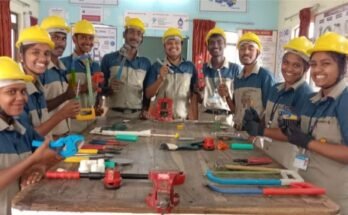Innovation and technology were prominent themes throughout the event. Many industries showcased their use of technology in their operations and emphasized the importance of technological knowledge in today’s job market. This type of sustainable event is highly effective as it provides a safe and controlled environment for individuals, industries, and policymakers to promote various initiatives and job opportunities.
A few months ago, I had the opportunity to be part of the district-level placement drive on 22/June/2023 at the Namakkal Kavignar Ramaligam Government Arts College for Women in the Namakkal region, Tamil Nadu, which was an excellent platform for various industries (around 22) to showcase their demand and promote skill development among the youth through placement drives.
The placement initiative was well-organized and targeted towards passed-out and final year students in the arts and sciences degree, given that the students have taken an upskilling course in new age technologies (Naan Mudhalvan courses) run by the State Skill Development Mission (Tamil Nadu Skill Development Corporation TNSDC) under the scheme of Naan Mudhalvan. This regional event hosted around 30 colleges who were willing to send their unplaced students to this nodal college for the placement drive. Around 339 candidates participated in the event, 242 students were shortlisted for further rounds, and 124 candidates provided on-spot job offers.
The district-level ones are different from the ones organized before, as they provide a larger platform for the arts & sciences colleges, students, and youth to unite and promote skill development and employment at a broader level. A few notable innovations and unique advantages of this district-level placement drive are listed below.
- This whole placement Initiative was exclusively for candidates belonging to arts & science degrees. No other streams such as engineering colleges were allowed to participate in the initiative. This provided equity to arts and sciences candidates in the job market.
- Secondly, one simple innovation, yet a powerful one, is providing admit cards for the candidates to engage in placement activities,
- A unique placement ID with a QR code was printed on each admit card. Using this, the Hiring managers (HR) could instantly provide the candidates’ status to the district administration and the nodal colleges. This level of digitization at a micro level (in a district with rural overtones) made possible the level of utilizing digital tools in ease of execution and tracking of candidates in providing employment opportunities.
- Overall 1107 admit cards were generated and sent to the registered candidates for this purpose (this was the first time an admit card was utilized for placement activities under the SSDM’s Naan Mudhalvan initiative)
- It was made sure that the designated nodal college was a government-run arts & science college. Promoting government initiatives in skilling, innovation, and higher education.
- Moreover, out of two other government colleges in the region, The Namakkal Kavignar Ramaligam Government Arts College for Women were selected because of their short distance from the district headquarters, where ample transport facilities were available (Less than 1 km).
- Networking is another advantage for candidates living on the outskirts of the district borders, as they can travel to neighboring districts more easily than to their own district Headquarters. Such placement drives have allowed engaging with nodal colleges in a centralized way for placement activities. This is a notable finding to highlight in the regional-level placement promotion.
District Level placement drive attracts industry participation, provides a larger skill development platform, and facilitates collaborations between district officials and industries. They can also promote rural connectivity and inspire youth to pursue careers in diverse fields, leading to a more diverse and skilled workforce and sustainable economic growth. Finally, the event also emphasized the importance of lifelong learning like communication, teamwork, problem-solving, adaptability, and special importance towards soft skills.
While many challenges remain to be addressed, the enthusiasm and commitment of the participants in these initiatives are a cause for optimism. By continuing to work together and leverage the opportunities provided by regional initiatives, we can build a brighter future for all young people, regardless of where they live or what opportunities they may have had in the past.
(Disclaimer: The views expressed in the article above are those of the author Karthik Raja Srinivasan, an MGNF Fellow. The matter and intent of this article has not been edited by skillreporter.com. Skill Reporter shall not be responsible for any person/ organization directly or indirectly.)
Join our exclusive community with a simple click! Embark on a journey of professional growth and be the first to get the latest insights – Subscribe to our Newsletter on LinkedIn



